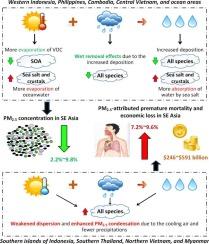气候变化对东南亚PM2.5形成化学的影响及其相关的人类健康影响和经济成本
IF 9.7
1区 环境科学与生态学
Q1 ENVIRONMENTAL SCIENCES
引用次数: 0
摘要
气候变化对环境和人类健康都构成重大威胁。细颗粒物(PM2.5)污染是受气候变化影响的主要问题之一,尤其是在东南亚等热带地区。然而,东南亚地区PM2.5的形成机制以及气候驱动对PM2.5水平、成分、人类健康和经济的影响尚未得到全面评估。本文采用区域气候和空气质量模型模拟了东南亚地区的PM2.5,确定了东南亚地区的PM2.5状态,并分析了氨(NH3)在PM2.5形成中的作用。然后,我们预测了不同共享社会经济路径(ssp)情景下的PM2.5,评估了气候变化对PM2.5的影响以及由此产生的人类健康影响和经济成本。我们发现,由于东南亚地区普遍存在NH3丰富的条件,NH3的减少对PM2.5浓度的影响很小。控制挥发性有机化合物(VOC)和二氧化硫(SO2)在减少东南亚的二次PM2.5方面更为有效。在气候变化的背景下,预计到2050年,在所有情景下,东南亚的PM2.5总浓度将下降 ~ 2-10 %,特别是在未来变暖的气候条件驱动下的二次有机气溶胶(SOA)水平(~ 41-61 %)。预计到2050年,在SSP126和SSP585下,东南亚由pm2.5导致的总过早死亡率将分别增加 ~ 7 %和 ~ 10 %,特别是在印度尼西亚和泰国。据估计,到2050年,根据SSP126和SSP585, pm2.5导致的过早死亡增加将分别造成4470亿美元和5910亿美元的经济损失(按2019年美元计算)。因此,更严格的PM2.5控制政策对于减轻气候变化下东南亚地区的PM2.5污染以及对人类健康的不利影响和经济成本至关重要。本文章由计算机程序翻译,如有差异,请以英文原文为准。

Effects of climate change on PM2.5 formation chemistry, and the associated human health impacts and economic costs in Southeast Asia
Climate change poses a significant threat to both the environment and human health. Fine particulate matter (PM2.5) pollution is one of the major issues affected by climate change, especially in tropical areas such as Southeast Asia. However, the PM2.5 formation mechanism and the climate-driven impacts on PM2.5 levels, compositions, human health, and economy in Southeast Asia have yet to be thoroughly assessed. Here we employed regional climate and air quality models to simulate PM2.5 over Southeast Asia, identifying the PM2.5 regime in Southeast Asia and analyzing the role of ammonia (NH3) in the PM2.5 formation. We then projected PM2.5 under various Shared Socioeconomic Pathways (SSPs) scenarios, evaluating the impacts of climate change on PM2.5 and the resultant human health impacts and economic costs. We found that NH3 reductions had minimal impact on PM2.5 concentration in Southeast Asia due to the prevalent NH3-rich conditions in the region. Controlling volatile organic compounds (VOC) and sulfur dioxides (SO2) is more effective in reducing secondary PM2.5 in Southeast Asia. Under climate change, the overall PM2.5 concentration in Southeast Asia is projected to decrease by ∼2–10 % by 2050 under all scenarios, notably for secondary organic aerosol (SOA) levels (∼41–61 %) driven by future warmer climate conditions. The total PM2.5-attributed premature mortality in Southeast Asia is projected to increase by ∼7 % under SSP126 and ∼10 % under SSP585 by 2050, particularly in Indonesia and Thailand. The increased PM2.5-attributable premature mortality was estimated to induce an economic loss of $447 and $591 billion (in 2019 USD), respectively, under SSP126 and SSP585 by 2050. Therefore, a more stringent PM2.5 control policy is essential to mitigate PM2.5 pollution and the adverse human health impacts and economic costs in Southeast Asia under climate change.
求助全文
通过发布文献求助,成功后即可免费获取论文全文。
去求助
来源期刊

Environment International
环境科学-环境科学
CiteScore
21.90
自引率
3.40%
发文量
734
审稿时长
2.8 months
期刊介绍:
Environmental Health publishes manuscripts focusing on critical aspects of environmental and occupational medicine, including studies in toxicology and epidemiology, to illuminate the human health implications of exposure to environmental hazards. The journal adopts an open-access model and practices open peer review.
It caters to scientists and practitioners across all environmental science domains, directly or indirectly impacting human health and well-being. With a commitment to enhancing the prevention of environmentally-related health risks, Environmental Health serves as a public health journal for the community and scientists engaged in matters of public health significance concerning the environment.
 求助内容:
求助内容: 应助结果提醒方式:
应助结果提醒方式:


